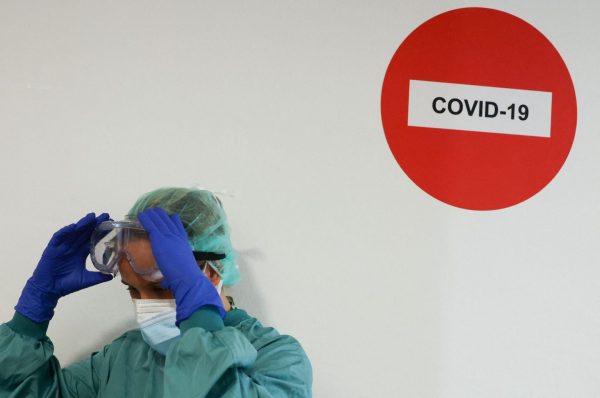
Greece is going through the most critical period in its battle with the coronavirus, with the cases showing a slight drop, at the moment when the Omicron variant is sweeping the country, while the health system is being tested once again.
The dominance of Omicron in the community is now confirmed by the measurements in the sewage of Thessaloniki, with this super-transmissible strain today representing 90% of the viral load of the deadly virus in Greece.
According to many scientists, the dominance of Omicron could mean the end of the pandemic, since the mild disease, combined with the small number of hospitalizations, but also the vaccination of the population, can bring the coveted immunity of the herd. In fact, there is no lack of optimistic scenarios that speak of the end of the pandemic in 2022.
However, apart from Omicron, there is the Delta mutation, which makes up the remaining 10%. It is a mutation that is less contagious, but more pathogenic, which seems to persist, despite its tendency to be slowing down.
So, despite the optimistic scenarios, it is understood that if we do not eliminate the Delta mutation, the end of the coronavirus will not come soon.
The Delta mutation is sequestered in the community
Characteristic are the words of the associate professor of Molecular Microbiology and member of the interdisciplinary team of Sewage Epidemiology of Thessaloniki University, Chrysostomos Dovas, who estimates that the complete disappearance of Delta will happen in the future, but not immediately, while pointing out that the abrupt transition to Omicron at the present time period carries risks.
“Because the immunity of the community due to the exposure to the Omicron strain is still small, the data from the sewage showed that when the mobility is high, not only does Omicron increase but also the very pathogenic Delta” he underlined speaking to iatronet.gr.
Based on the measurement of wastewater on 11/1, the viral load of Delta in Thessaloniki has been reduced by half compared to 19/12, when Omicron was detected for the first time.
“The dispersion of the Delta strain from the date of emergence of Omicron onwards shows fluctuations, but as a general trend it is decreasing at a slow pace based on the recordings in the sewage from 3/1 onwards. This is encouraging, however the relative burden on the health system still remains significant and we should be wary of estimates for a disappearance of Delta soon,” said the professor, adding, however, that there is reasonable optimism that this will happen in the future, through immunity from Omicron infection.
“There are scientific reports that Omicron contamination may protect against Delta contamination and to the extent that this is the case, combined with the mitigation measures and trends we see make us optimistic about Delta’s leaving the community in the future.” .
How Omicron leads to endemicity
At the same time, Mr. Dovas characterizes the view that the specific virus develops causally into less pathogenic because the disease reduces the possibility of its spread as simplistic . In the case of COVID, he explains to iatronet.gr, a significant number of people who transmit the virus are asymptomatic, while in those who show symptoms, the transmission of SARS-CoV-2 to other people occurs early when the virus initially multiplies in the upper respiratory tract of those infected.
In addition, serious illness, when it occurs, comes later when we have a severe infection of the lower respiratory tract, after the disease has already spread in the community. So there is no significant evolutionary pressure that will make SARS-CoV-2 less pathogenic, as long as its easy spread is already ensured.

The case of the emergence of the Delta strain, which is more pathogenic than the previous ones, is a typical example. Based on the above and the evolutionary theory in corresponding viruses, the emergence of new less pathogenic strains was expected to be most likely the result of random genetic aberration and their prevalence is possible only in conditions of low circulation of the virus, ie after it becomes endemic.
In the case of Omicron, however, things are different. “We have had an interesting development that shows that the virus, fortunately, has physical limitations in terms of its simultaneous adaptation to the body’s systems. Research to date shows that part of its increased transmissibility is due to its adaptation to the upper respiratory tract, which is necessarily combined with less adaptation to the lower respiratory tract.
This is good news because it shows that there is an inverse relationship between transmissibility and severe disease and gives us hope that we are heading into a period where the virus will become endemic sooner than we expected. “Until that happens, it will be preceded by a period of great uncertainty and that is why we are all called upon, society and the state, to show social responsibility,” he points out.
Impossible to predict the future of the pandemic
In any case, the end of the pandemic is impossible to predict, because viruses do not always evolve in a predictable pattern. This is emphasized, among other things, in an article on ABC News by Dr. Jess Dawson, adding that thousands of variants of COVID have been identified, each with unique mutations.
But most new variants appear and then disappear quickly, unable to compete with the dominant variant.
Some variants, however, have clear “benefits to continued survival, such as those that avoid the immune system and spread easily,” said Dr. Abir Hussein of the University of Washington Medical Center.
Omicron and wall of immunity
In any case, experts warn that it is important to assess the severity of Omicron in the context of existing immunity through vaccines and previous infections.
“It is difficult to determine through Delta or Omicron whether the variants are becoming more or less contagious. This is because these variants came at a time when we were highly immune to SARS-CoV-2 coronavirus in some countries,” said Andrew Pekoz, a professor of microbiology.
People who have been vaccinated or recently infected will have milder symptoms if they become ill or re-infected, according to studies. “This is not because the variant is less contagious, but because the immune system was prepared from previous vaccination and infection,” he added.

Experts argue that Omicron should not be considered a less lethal form of COVID. Even though it has a lower mortality rate, the Omicron variant is significantly more contagious, leading to more deaths overall, the report said.
The U.S. Centers for Disease Control and Prevention predicts that 22,000 more people could die from complications of COVID-19 in the next two weeks. People who are not vaccinated are at a much higher risk, with officials estimating that they are 17 times more likely to be hospitalized and 20 times more likely to die from COVID-19 than people who have been vaccinated.
“The available vaccines for COVID provide immunity to a range of variants and continue to be the first line of defense,” said Dr. John Brownstein, head of innovation at Boston Children’s Hospital and a contributor to ABC News.
Regarding the future of the pandemic, experts say that new variants may appear in the future, but it will not be easy to predict.
Latest News

Lavrio Port Authority Next Up for Privatization
A deadline for the submission of expressions of interest is May 14, 2024

Eurostat: Greece Records Largest Drop in Natural Gas Prices in 2nd Half of 2023
The price of electricity and natural gas in Europe was down following a substantial surge that began before the Russian invasion of Ukraine and peaked in 2022

GEK TERNA Still Considers Leveraging Concessions Portfolio as Financial Tool
President and CEO of Gek Terna George Peristeris explained the company's plans on Tuesday on the sidelines of the inauguration of sections of Greece's E65 highway

NielsenIQ: 3% Supermarket Revenue Increase in Q1
Private label products are gaining traction, comprising 25.4% of shopping basket shares, up from 24.7%

Store Hours Change Today in Observation of Orthodox Easter
The President of the Athens Chamber of Commerce hopes the Easter period will provide a much-needed boost to retail traffic in the capital

Athens-area Mass Transit Systems Set to Finally Install Contact-less Fare Payment
Paying fares via bank cards, smartphones and smartwatches in all mass transit systems in the Greek capital, namely, buses, trolleys, the metro and tram lines, is scheduled by the end of the year

Council of State Rejects Motion Against Thessaloniki Motorway Project
The motion was filed earlier this month by three local citizens’ and environmental groups and generated a high court decision for a temporary stay in construction

Greek 30Y Bond Issue Oversubscribed by 11 Times
Very high demand pushed down the coupon's interest rate to 4.125%

Athens Int’l Airport Wins Top Prize at Routes Europe Awards
The Routes business is focused entirely on aviation route development and the company's portfolio includes events, media and online businesses

IOBE: Income Gap Between Poor and Wealthy Greeks Widens
The findings in the analysis, entitled “Progressivity in Income Taxation in Greece, 2012-2021", paint a bleak picture for Greeks in the bottom half of the income bracket, warning that income inequality is growing












































 Αριθμός Πιστοποίησης Μ.Η.Τ.232433
Αριθμός Πιστοποίησης Μ.Η.Τ.232433